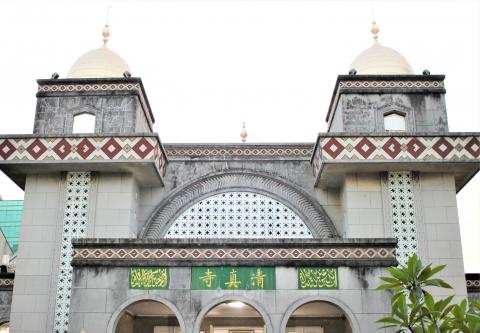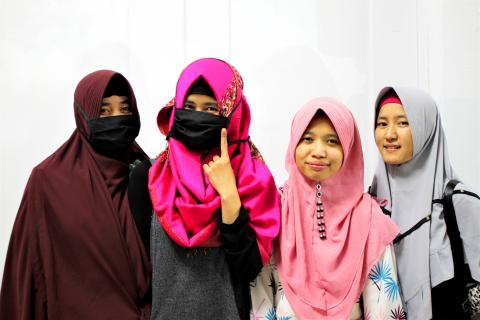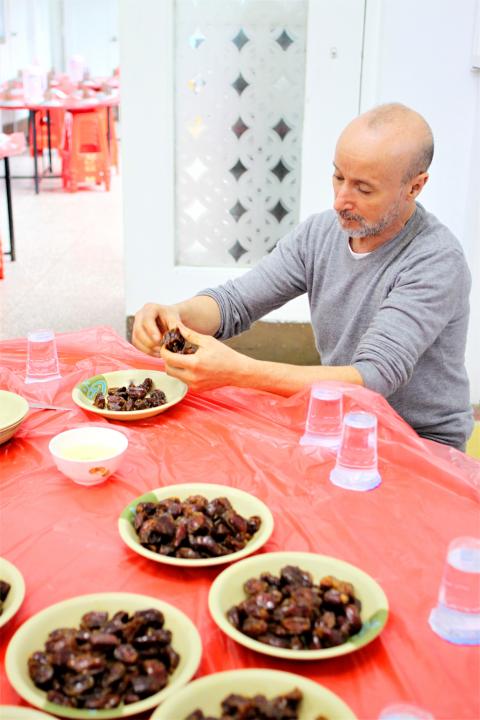When Zaharah Chen (陳俞如) converted to Islam in the summer of 2013, it was a momentous decision that she intended to honor in all aspects of her life. But when she wore a headscarf to work the next day, the sight shocked her employer, who at first thought that Chen was dressing up for cosplay.
After being informed of its religious significance, “he said, ‘You’ve become a Muslim? Do you know that Islam is a terrorist religion? Why would you join a religion like that?’” Chen recounts.
Chen was dismissed later that day on the grounds that her work was unsatisfactory. She decided not to dispute the firing so as not to put her long-time employer in a difficult position. But the experience was dispiriting.

Photo: Davina Tham, Taipei Times
“I felt very sad. Why would you negate a person because of her religious beliefs, especially when what you think about her religion is not correct at all?” she tells the Taipei Times.
In a society where ignorance and insensitivity toward Islam are still common, Taipei’s Grand Mosque has become a sanctuary where Chen and other Muslims find community and understanding, especially during the holy month of Ramadan.
THE GRAND MOSQUE

Photo: Davina Tham, Taipei Times
Chen is a lifelong native of Taipei. But on the day of her conversion at the Grand Mosque, she, like many locals, found herself in a part of the city she had never set foot in before.
The Grand Mosque, with its full green dome and two minarets, has been part of the cityscape since 1960. It is the largest of eight mosques in Taiwan. Chairperson Feng Tung-yu (馮同瑜) estimates that 2,000 people pass through the mosque’s doors each week.
Attendance peaks during Ramadan, which falls between May 6 and June 4 this year. From sunrise to sunset, Muslims who are physically able are required to abstain from all food and drink.

Photo: Davina Tham, Taipei Times
Following Islamic custom, the Grand Mosque provides complimentary iftar — a communal evening meal to break fast — throughout Ramadan. Donations from the congregation, ranging from NT$30,000 to NT$50,000, cover the cost of each meal. On the day that I visit, a group of Pakistani volunteers are preparing curries, salad, rice and flatbread.
During the holy month, Juniata, an Indonesian domestic helper working in Hsinchu County, makes a special weekend trip to the Grand Mosque for prayers and iftar.
When I meet her, Juniata is huddled together with other young Indonesian women, all of whom she has just met earlier that day during prayers. The women chitchat among themselves in their mother tongue, but switch to a colloquial Chinese outside of their group.

Photo: Davina Tham, Taipei
The iftar mainly draws people from low to middle-income brackets, migrant workers and exchange students. All of this makes for a strikingly international congregation, where strangers of myriad ethnicities sit shoulder-to-shoulder at the dining table.
But not everyone is there for God alone, nor even for the free meal. The prospect of being in a space where Muslims are the majority, moving freely among fellow worshipers, can be a salve to the daily stress of living as a minority.
BRIDGING THE GAP
Juniata and Shofia, another domestic worker, consider themselves fortunate because their employers respect their right to practice their religion.
Both women fast during Ramadan, wear headscarves at work and sometimes cook and store their own halal meals in their employers’ kitchens.
When I ask if fasting makes it hard to carry out physically-demanding tasks, Juniata replies that it’s no more difficult than usual.
“Our bosses are very good,” she says. “But there are some bad ones, too.”
Shofia recalls an uncomfortable experience with her employers’ friends, who questioned why she wore a headscarf, long-sleeved shirt and long pants even in the heat of summer.
“They might think it is strange to cover up their own hair,” Shofia says, frowning. But on the contrary, “if I don’t cover up my hair, then I feel strange.”
Chen, who has studied Islam in Malaysia and the United Arab Emirates, says that even she at first avoided Islam when embarking on the religious exploration that eventually led to her conversion.
Among most Taiwanese “there is no clear understanding of Islam, only certain messages conveyed by the media,” Chen says. Initially, she too was put off by stereotypes that associate Islam with terrorism and the Sept. 11, 2001 attacks in the US.
Partly to combat ignorance about Islam, and partly because of the secular environment in which it operates, the Grand Mosque makes an effort to keep its doors open to non-believers. Women whose heads are uncovered are not turned away. Worshipers offer food and greetings to visitors, regardless of their religion.
“We are more easygoing with non-Muslims, because we also hope that they can understand Islam,” Feng says. “If you have too many restrictions and you tie their hands, they won’t come. Then with time as they grow distant, they will become estranged.”
Despite Chen’s bitter experience with her former employer, she too believes that understanding is possible with time and patience.
Chen’s parents also questioned their daughter’s decision to convert, asking why she was joining a religion that they felt was oppressive toward women. She made an effort to explain what Islam meant to her and clarify their misconceptions.
Six years on, Chen says that her parents have now grasped and even agree with the basic precepts of Islam, like why Muslim women cover themselves up. Both generations have reached an understanding, even as Chen’s parents continue to practice folk traditions, like ancestral worship.
And when faced with questions from the ignorant or skeptical, she has gained an unexpected ally.
Now an employee of the Chinese Muslim Association (中國回教協會), Chen once found herself engaging visitors at the annual Taipei Eid al-Fitr and Muslim Festival. Curious passersby asked her about the Muslim attire, dietary restrictions and other practices they find exotic.
Chen’s mother happened to be there that day, and spoke up.
“Sometimes even she will help me to explain why I don’t eat pork and why I am dressed like this,” Chen says.

Most heroes are remembered for the battles they fought. Taiwan’s Black Bat Squadron is remembered for flying into Chinese airspace 838 times between 1953 and 1967, and for the 148 men whose sacrifice bought the intelligence that kept Taiwan secure. Two-thirds of the squadron died carrying out missions most people wouldn’t learn about for another 40 years. The squadron lost 15 aircraft and 148 crew members over those 14 years, making it the deadliest unit in Taiwan’s military history by casualty rate. They flew at night, often at low altitudes, straight into some of the most heavily defended airspace in Asia.

Many people in Taiwan first learned about universal basic income (UBI) — the idea that the government should provide regular, no-strings-attached payments to each citizen — in 2019. While seeking the Democratic nomination for the 2020 US presidential election, Andrew Yang, a politician of Taiwanese descent, said that, if elected, he’d institute a UBI of US$1,000 per month to “get the economic boot off of people’s throats, allowing them to lift their heads up, breathe, and get excited for the future.” His campaign petered out, but the concept of UBI hasn’t gone away. Throughout the industrialized world, there are fears that

Like much in the world today, theater has experienced major disruptions over the six years since COVID-19. The pandemic, the war in Ukraine and social media have created a new normal of geopolitical and information uncertainty, and the performing arts are not immune to these effects. “Ten years ago people wanted to come to the theater to engage with important issues, but now the Internet allows them to engage with those issues powerfully and immediately,” said Faith Tan, programming director of the Esplanade in Singapore, speaking last week in Japan. “One reaction to unpredictability has been a renewed emphasis on

Taiwan’s democracy is at risk. Be very alarmed. This is not a drill. The current constitutional crisis progressed slowly, then suddenly. Political tensions, partisan hostility and emotions are all running high right when cool heads and calm negotiation are most needed. Oxford defines brinkmanship as: “The art or practice of pursuing a dangerous policy to the limits of safety before stopping, especially in politics.” It says the term comes from a quote from a 1956 Cold War interview with then-American Secretary of State John Foster Dulles, when he said: ‘The ability to get to the verge without getting into the war is